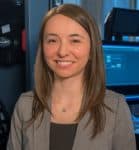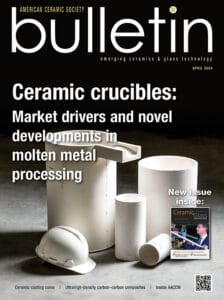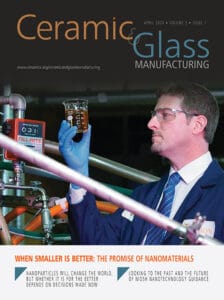Jubilee Global Diversity Awardee 2023
 Dr. Valerie Wiesner is a Research Materials Engineer in the Advanced Materials and Processing Branch at NASA Langley Research Center (LaRC) in Hampton, Virginia. She recently served as Acting Assistant Branch Head for the Crew Systems and Aviation Operations Branch at LaRC in 2022. Her research focuses on developing and understanding degradation of ceramic coatings and composites for extreme environment applications ranging from reusable hypersonic vehicles to lunar and planetary exploration and surface operations, as well as on ceramic processing and additive manufacturing. Prior to joining LaRC in 2019, she began her NASA career as a Research Materials Engineer in the Ceramic and Polymer Composites Branch at NASA Glenn Research Center (GRC) in Cleveland, Ohio, in 2014 after completing a Pathways Internship as a Ph.D. student. She served as lead investigator for evaluating damage of environmental barrier coatings designed to protect ceramic matrix composite components caused by particulates, such as sand and volcanic ash, when ingested by aircraft engines.
Dr. Valerie Wiesner is a Research Materials Engineer in the Advanced Materials and Processing Branch at NASA Langley Research Center (LaRC) in Hampton, Virginia. She recently served as Acting Assistant Branch Head for the Crew Systems and Aviation Operations Branch at LaRC in 2022. Her research focuses on developing and understanding degradation of ceramic coatings and composites for extreme environment applications ranging from reusable hypersonic vehicles to lunar and planetary exploration and surface operations, as well as on ceramic processing and additive manufacturing. Prior to joining LaRC in 2019, she began her NASA career as a Research Materials Engineer in the Ceramic and Polymer Composites Branch at NASA Glenn Research Center (GRC) in Cleveland, Ohio, in 2014 after completing a Pathways Internship as a Ph.D. student. She served as lead investigator for evaluating damage of environmental barrier coatings designed to protect ceramic matrix composite components caused by particulates, such as sand and volcanic ash, when ingested by aircraft engines.
Dr. Wiesner has co-authored over 30 publications, including 20 peer-reviewed articles, and over 90 technical conference and seminar presentations. She holds leadership roles in professional societies, namely the American Ceramic Society (ACerS), ASM International and American Institute of Aeronautics and Astronautics (AIAA), and in technical conferences. Notably, she has served as Program Chair of the International Conference on Advanced Ceramic and Composites (ICACC) in 2022, Chair of the ACerS Engineering Ceramics Division from 2020-2021 and several ACerS committees, including Member Services and Strategic Planning and Emerging Opportunities Committees. She was a founding member and lead of the International Forum for Aviation Research (IFAR) Early Career Network (ECN) and served as the NASA representative from 2016-2020 to connect young professionals from the international aeronautics research community. She actively supports and leads STEM engagement and mentoring efforts at all education levels. She has received awards, including the NASA Early Career Achievement Medal, IFAR Distinguished Service Award and the ACerS Coble Award for Young Scholars.
Dr. Wiesner earned a Ph.D. in materials engineering from Purdue University in West Lafayette, Indiana, B.A. in physics with certificate in Japanese Language from Carleton College in Northfield, Minnesota, and certificate in Japanese language and culture from Waseda University in Tokyo, Japan. Prior to graduate school, she spent one year working as a primary and junior high school teacher and translator for the Tokyo Metropolitan Board of Education in Japan.
Title: Materials discovery for lunar dust tolerant applications
Abstract: Materials capable of withstanding the harsh lunar environment are needed to support long duration, sustainable missions on the Moon’s surface. Without an atmosphere, the lunar surface is exposed to the vacuum of space, large temperature fluctuations, and intense radiation, among other factors. Notably, lunar dust significantly threatens durability and reusability of components and vehicles due to its fine, jagged morphology and highly abrasive nature. These characteristics result in particles eroding, adhering, and/or embedding onto component surfaces and into device-confined geometries (e.g., gear housing, interlocking systems, etc.) potentially causing premature failure. A key barrier hindering materials discovery for lunar dust tolerant applications is a lack of standard lab-based methods to evaluate material properties and performance under representative conditions.
To select materials resistant to wear by lunar dust, research activities in support of identifying, developing, and characterizing material candidates, such as ceramics, as well as processing and manufacturing approaches, including laser ablation patterning and additive manufacturing, will be presented. Results from testing and evaluation methods devised to mimic aspects of lunar dust degradation, including adhesion and abrasion, along with development of a custom-built extreme environment wear testbed that simultaneously subjects materials to wear and aspects of the lunar environment will be shared.
Subscribe to Ceramic Tech Today

Don’t miss the latest ceramic and glass materials news. Receive the CTT newsletter to your email three times a week by subscribing at this link.
Subscribe to Ceramic & Glass Manufacturing Weekly

Don’t miss the latest ceramic and glass business news. Receive the C&GM Weekly newsletter to your email every Monday by subscribing at this link.


